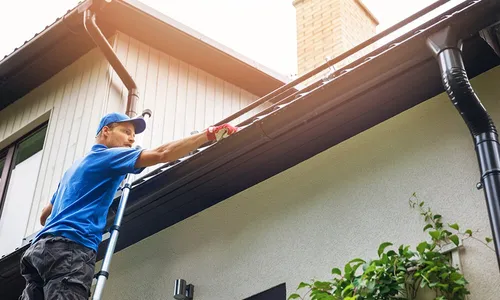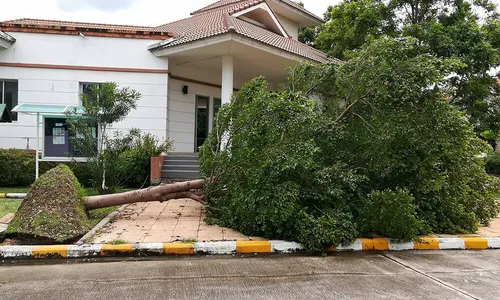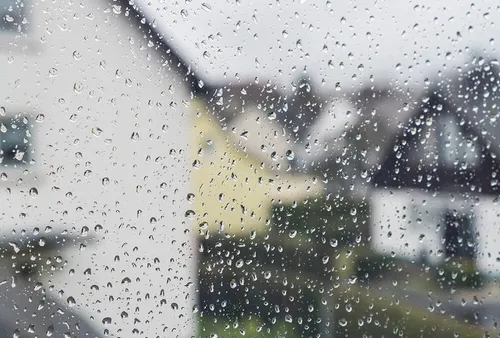There’s no way to control the weather, but there are ways to control the way we prepare our homes for the unexpected. This year we’ve seen excessive flooding around the United States, along with an influx in earthquakes around the world. Even Nebraska, far from oceans or large bodies of water, has been intermittently experiencing what feels like torrential downpours for the last couple weeks. Despite not even being in the storm season of mid-late spring, we’re seeing some crazy weather patterns. This week we’re here to share some steps about how to protect your home from unpredictable weather damage.

STEP ONE: TAKE ADVANTAGE OF THE CLEAR WEATHER
Long before you sense a storm is about to hit, it’s time to prepare. By taking simple steps when the weather is clear, you can better protect both your home and family from a weather catastrophe.
- Clean your gutters: Repairing and clearing out your gutters will help all of the rain water flow where it’s supposed to. Make sure all water spouts are facing away from your foundation to prevent flooding.
- Fix any loose siding or shingles: It only takes one loose piece of your home’s exterior protection to break off and allow wind and water to get under and pry the rest off. With one shingle or piece of siding missing, the entire exterior of your home becomes more vulnerable. If you’re unsure of how to check the integrity of your roof or siding, call in the professionals to help.
- Reinforce windows and doors: If a window or door isn’t sealed properly, the wind and rain will enlarge the crack or even shatter the window glass due to instability. Replacing windows can be an expensive repair, so it’s better to take the precautions early to save yourself headaches and money in the long run.
- Build a storm shelter: While there are elaborate and expensive ways to build a storm shelter, finding the safest part of your home and making it “storm-proof” is better than not having a storm hideout at all. For Nebraskans, the basement is going to be the best choice for a storm shelter since the most severe weather we’re likely to encounter is a tornado. For example, a basement storage room with all loose items secured and left a section clear for blankets, water, flashlights, a radio, and other supplies would be ideal. That way, when you’re caught off-guard by a storm, you don’t have to scramble to prepare a safe space.
STEP TWO: STAY CALM WHEN THE STORM BEGINS
Once you get word that a storm is on it’s way, stay calm. It’s important to keep a level head so you remember what to do to prepare immediately. Also, keeping your kids and pets relaxed can help make waiting the storm out a bit easier.
- A quick pick-up: If the weather is still safe, walk around your perimeter. Pick up all of your pink lawn flamingos, chairs, toys, or other items that might go flying and cause damage to your house. Tuck them away in the garage, and head inside.
- Grab your generator: While some power generators stay hooked up year-round, others are portable and will need to be set up during a storm. For longer power outages, you’ll be relieved you decided to invest in a power generator.

STEP THREE: ASSESS THE AFTERMATH
Even after the storm, it’s important to make sure it’s safe to go outside. Keep your radio or phone on and take the following precautions once you’re sure the danger has passed.
- Keep your kids and animals safe: Depending on the severity of the storm, you never know what you’re about to walk out to. There might be fallen trees, broken glass, or other hazardous things that you need to scope out before bringing small children or pets outside.
- Prioritize damage: A broken fence post isn’t as crucial as shattered windows or a leaking roof. When assessing your property immediately following a storm, write a list that you can later organize as you decide what to repair first.
It’s also helpful to categorize damage into three levels of priority so you know who to call first for help:
- Aesthetically displeasing. Still functional. (This looks like minor hail damage or destroyed landscaping).
- Not functional, but not causing more damage. (Your storm door may have fallen off, or parts of your fence have snapped).
- Not functional, continually causing additional damage to property. (Windows have shattered allowing rain and wind inside, or a massive amount of shingles have broken off leaving holes in your roof).
If you need help preparing your home’s exterior before a storm or fixing damage after one, call us today at J-Tech Construction. We’re here to help you through all of the steps of handling weather, even the aftermath, so you’re always prepared!





